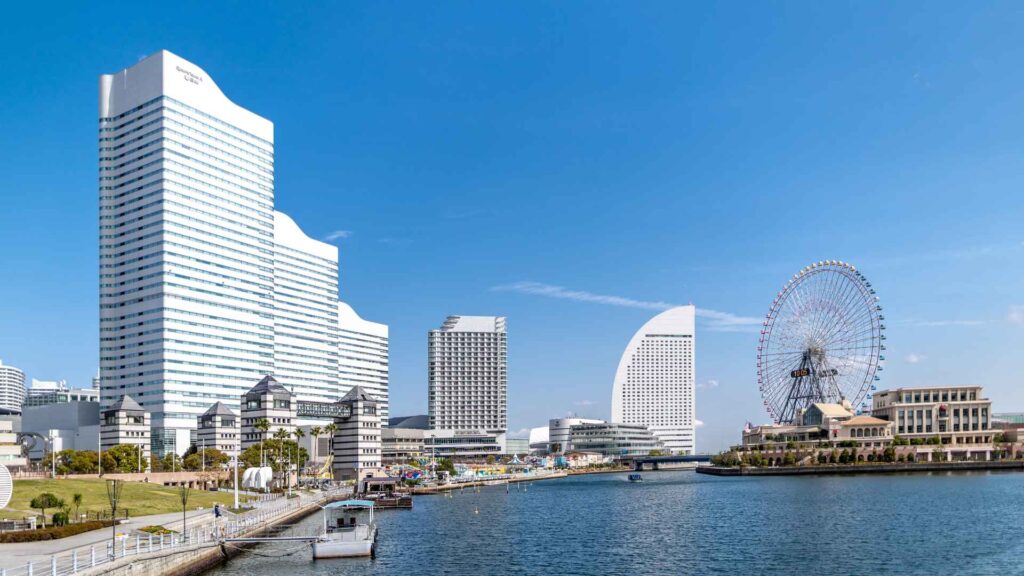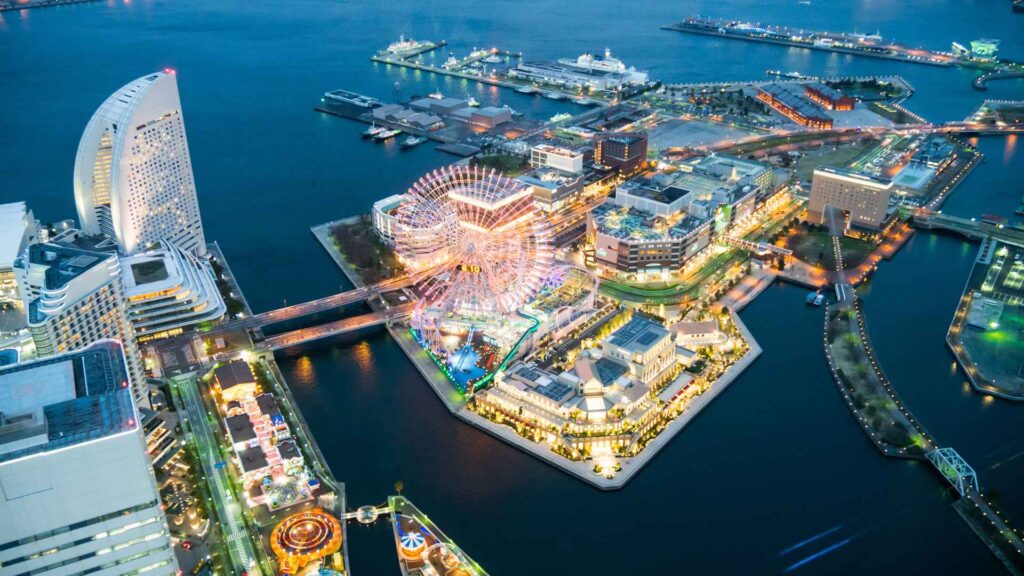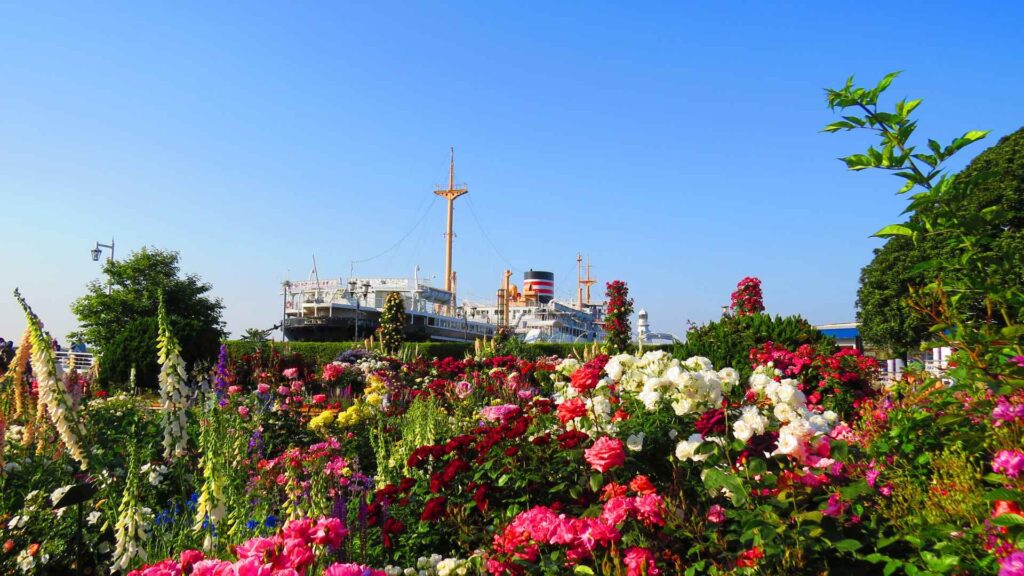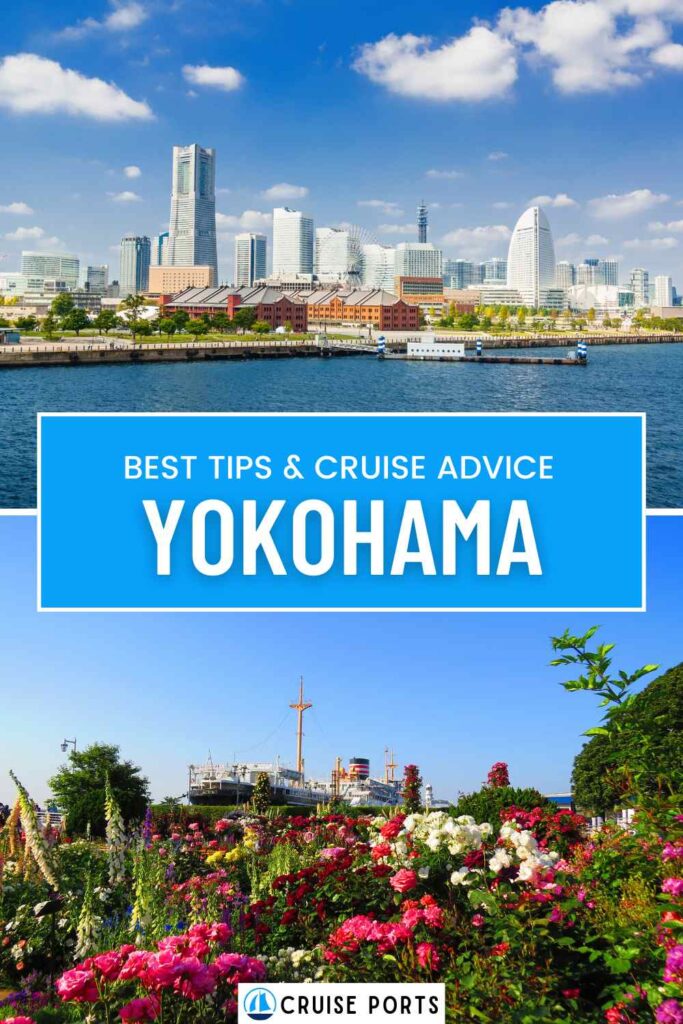Yokohama Cruise Port shines as a lively gateway to modern Japan.
This bustling waterfront city merges urban sophistication with cultural heritage, offering a remarkable experience for travelers.
From world-class dining to iconic historical sites, Yokohama enthralls visitors who seek an exciting taste of everything Japan’s second-largest city has to offer.
Understanding Yokohama Cruise Port
Yokohama Cruise Port, often referred to as the Port of Yokohama, stands as a dynamic entry point into Japan.
Located in Kanagawa Prefecture on Tokyo Bay, Yokohama is just a short distance from central Tokyo, making it an ideal destination for cruise passengers seeking both cosmopolitan energy and local charm.
Although it’s one of the busiest ports in the country, the city itself never feels overwhelming.
Instead, you’ll find an intriguing mix of glitzy skyscrapers, centuries-old temples, bustling shopping streets, and tranquil gardens, all harmoniously coexisting by the water.

A Glimpse into the Past
- Yokohama was a sleepy fishing village until the mid-19th century when Japan opened its doors to international trade.
- Once the port became a hub for foreign merchants, Yokohama quickly modernized, blending Western influences with Japanese tradition.
- Today, reminders of its cosmopolitan roots remain evident through the city’s architecture, diverse dining scene, and cultural events.
Modern Cruise Terminal Facilities
Stepping off your ship, you’ll notice a well-organized, tourist-friendly environment.
English signage is plentiful, and staff members often speak basic English to assist with directions and information. Within the cruise terminal and nearby areas, you’ll typically find:
- Currency Exchange Counters: Conveniently convert dollars or euros into yen without hassle.
- Wi-Fi Hotspots: Many parts of the terminal offer free internet access so you can plan your day on the go.
- Baggage Services: Secure lockers and porter services allow you to travel light during city exploration.
Proximity to Iconic Attractions
Because Yokohama sits on Tokyo Bay, you can enjoy scenic harbor views right from the start.
Major spots like Minato Mirai 21 (a futuristic waterfront district), Chinatown, and Yamashita Park are within walking or short taxi distance.
A little further afield, but still easily reachable, you have Sankeien Garden and the Shin-Yokohama Ramen Museum. These attractions capture the breadth of Yokohama’s personality—modern, historic, and everything in between.
Why Yokohama?
What sets Yokohama apart is the city’s laid-back international vibe. While Tokyo dazzles with an intensely fast pace, Yokohama offers a more relaxed approach to urban life.
You’ll experience top-tier shopping, dining, and entertainment with fewer crowds and a waterfront ambiance.
The city’s ports and promenades also make for lovely afternoon strolls, offering panoramic views of the harbor and skyline. Plus, if you’re up for day trips, Tokyo is just a quick train ride away.
Whether you’re fascinated by its deep-rooted history, eager to indulge in local and international cuisine, or simply ready to explore a modern Japanese metropolis, Yokohama Cruise Port provides the perfect launchpad for every kind of travel adventure.
Getting Around: Transportation Tips
Navigating Yokohama is surprisingly easy, thanks to its well-planned transportation network.
Whether you prefer the efficiency of trains and subways or the convenience of taxis, you’ll find plenty of options suited to your budget and comfort level.
Here’s how to make the most of your time in this sprawling yet accessible port city.
Train and Subway Networks
- JR Lines: The Japan Railways (JR) network includes Yokohama Station as a major hub, connecting you to Tokyo and other parts of the country. If you have a Japan Rail Pass, it’s valid on most JR lines, making intercity travel a breeze.
- Minatomirai Line: Specifically designed to connect central Yokohama’s key sightseeing areas, this line is a favorite among travelers. It links Yokohama Station to popular stops like Minato Mirai, Bashamichi, Nihon-Odori, and Motomachi-Chukagai (Chinatown).
- Subway Lines: The Yokohama Municipal Subway runs both Blue Line and Green Line routes. The Blue Line is especially handy for reaching Shin-Yokohama (and the famous Ramen Museum).
Buses and Tourist Loops
If you prefer above-ground travel, Yokohama boasts an extensive bus network.
Look for the Akai Kutsu (Red Shoes)tourist bus, a charming retro-style service that loops around major spots like Chinatown, Yamashita Park, and the Red Brick Warehouse.
It’s an affordable way to see the city while enjoying a nostalgic ride. Some key points:
- Frequent Stops: Buses typically run every 15 to 30 minutes, so you’ll rarely wait long.
- Flat Fare: One-day passes can be bought for unlimited rides, making it convenient for multiple stops.
Taxis and Ride-Hailing
- Taxis: A reliable option for shorter distances or if you’re in a group and want door-to-door service. Fares can add up, but taxis in Japan are known for cleanliness, professionalism, and safety.
- Ride-Hailing Apps: Services like Uber do exist, though they’re not as ubiquitous in Japan as in some other countries. You may find local ride-hailing options, too, often integrated with major taxi companies.
Ferries and Water Buses
Yokohama’s waterfront location lends itself to scenic ferry rides. The Sea Bass water bus connects spots like Yokohama Station (East Exit) and Yamashita Park.
It’s a fun, budget-friendly way to experience the harbor views. If time allows, consider a short cruise around the bay at sunset for a spectacular skyline display.
Smart Cards and Tickets
- IC Cards: Prepaid travel cards like Suica and Pasmo are widely accepted on trains, buses, and even some taxis. These cards can be purchased or topped up at station ticket machines.
- Tourist Passes: If you plan on hopping from one attraction to the next, day passes or weekend passes (available for both trains and buses) can save you money and time. Just tap or show your pass and you’re good to go.
Tips for a Smooth Journey
- Avoid Rush Hour: Try to plan your travels outside the peak commuter times (7:00-9:00 AM and 5:00-7:00 PM).
- Respect Etiquette: Keep noise levels down on public transport, put your phone on silent mode, and refrain from eating on trains.
- Ask for Help: Station staff are generally helpful and may speak some English. Don’t hesitate to approach them if you’re confused about directions or routes.
By familiarizing yourself with Yokohama’s transit system, you’ll move seamlessly between the cruise port and the city’s hottest spots.
Whether you opt for the scenic route via water bus or zip around by subway, Yokohama’s transportation options ensure you spend less time navigating and more time experiencing its unique charm.

Exploring the Best of Yokohama
Yokohama offers a wealth of attractions that capture the city’s spirit: innovative architecture, enthralling entertainment, and nods to its international heritage.
Whether you have just a few hours or several days, these sites deserve a spot on your must-see list.
Minato Mirai 21
This futuristic waterfront district is the city’s showpiece—a stunning blend of shopping, dining, entertainment, and green spaces.
- Landmark Tower: Once Japan’s tallest building, it boasts an observatory on the 69th floor. You can enjoy panoramic views of Yokohama’s skyline and even spot Mount Fuji on clear days.
- Cosmo Clock 21: This enormous Ferris wheel doubles as a digital clock, lighting up the night sky.
- Queen’s Square and MARK IS: High-end malls filled with global brands, local boutiques, and international eateries.
Yamashita Park
A short walk from Minato Mirai leads you to Yamashita Park. Framed by the bay on one side, this park is a favorite spot for leisurely strolls and picnics.
- Hikawa Maru: Permanently docked at the park, this historic ocean liner once carried passengers across the Pacific. You can tour the vessel’s Art Deco interiors.
- Harbor Views: Relax on a park bench and watch ships sail by, soaking in the fresh sea breeze.
Yokohama Chinatown
Ranked among the largest Chinatowns in the world, Yokohama’s version is a vibrant tapestry of bright signboards, ornate gates, and mouthwatering aromas.
- Street Food Galore: Try steamed buns, dumplings, and sweet pastries from food stalls that line every alley.
- Authentic Restaurants: Feast on Peking duck, fresh seafood, and regional Chinese specialties.
- Cultural Festivals: Chinese New Year celebrations here feature lion dances, fireworks, and special limited-time dishes.
Red Brick Warehouse (Aka-Renga Sōko)
A fusion of historic architecture and modern flair, these two iconic buildings once served as customs warehouses. Today, they’re repurposed as:
- Shopping Arcades: Homegrown designers, artisanal crafts, and unique souvenirs.
- Event Spaces: Seasonal markets, beer festivals, and music concerts often take place in the outdoor plaza.
- Riverside Dining: Cafés and restaurants boasting excellent harbor views.
Sankeien Garden
For a peaceful escape, head to Sankeien, a sprawling Japanese garden dotted with ponds, tea houses, and winding pathways.
- Historic Buildings: Within the garden, you’ll find relocated structures like an ancient pagoda and feudal lord residences.
- Seasonal Beauty: Cherry blossoms in spring, irises in early summer, and fiery maple leaves in autumn.
- Teahouses: Traditional tea ceremonies sometimes take place, offering a glimpse into centuries-old customs.
Cultural Snapshot
Yokohama’s character is defined by its role as a gateway between Japan and the world.
You’ll see Western-style buildings near the harbor, a swirl of Chinese influence in Chinatown, and quintessential Japanese landscapes in places like Sankeien Garden.
Each neighborhood reveals a different chapter of Yokohama’s story, from the port’s early days of foreign trade to its current status as a cutting-edge, international city.
Plan your itinerary based on your interests—modern architecture, cultural history, or leisure by the waterfront. Whatever your focus, Yokohama delivers a balanced mix of tradition and innovation that keeps visitors enthralled at every turn.
Dive into Yokohama’s Culture and Traditions
While Yokohama’s shimmering skyline and sleek modern districts are striking, the city’s cultural layer runs far deeper than its futuristic facade.
Centuries of foreign trade and cultural exchange have created a tapestry that blends Japanese heritage with international flair. Exploring this side of Yokohama uncovers a rich history of openness, artistry, and tradition.
Historical Influences
- Opening of the Port: In 1859, Yokohama’s port was one of the first in Japan to open for international trade. Western architecture, fashion, and lifestyle soon found a home here, shaping Yokohama into Japan’s most cosmopolitan city at the time.
- Yamate Bluff & Western Residences: High above the bay, the Yamate area still features Western-style mansions that once housed foreign diplomats and traders. Many of these historical homes are open to the public, serving as museums that recount Yokohama’s early international days.
Traditional Celebrations
- Yokohama Matsuri: During summer, festivals pop up across the city, featuring mikoshi (portable shrines), traditional music, and lively parades.
- Chinese New Year in Chinatown: The city’s strong Chinese influence shines during this festive season, with lion dances and vibrant decorations attracting thousands of visitors.
Arts and Crafts
- Ceramics and Pottery: While not as famous as regions like Kyoto or Arita, Yokohama still has its share of local artisans who create modern and classic ceramics. Browsing local craft shops might reveal a unique souvenir.
- Yokohama Museum of Art: Showcasing a broad range of contemporary and traditional works, this museum often hosts special exhibits that reflect the city’s global perspective.
- Noge Arts Scene: The bohemian Noge district brims with live music bars, art galleries, and independent theaters, representing Yokohama’s creative pulse.
Spiritual Touchstones
Despite its modern aura, Yokohama still has hidden shrines and temples where you can experience Japan’s spiritual heritage.
- Iseyama Kōtai Shrine: Overlooking the city from a quiet hillside, this shrine offers a peaceful retreat.
- Local Temples: Smaller neighborhood temples often host seasonal events like nighttime illuminations, fostering a sense of community and tradition among residents.
Cultural Etiquette
- Politeness and Bowing: Like any Japanese city, Yokohama appreciates respectful interactions. Bowing, using polite greetings, and taking off shoes in certain indoor spaces are common practices.
- Photography: Always ask for permission before photographing people, particularly in sacred spaces or private neighborhoods.
- Blending In: Because Yokohama is used to international visitors, local residents are generally welcoming. However, learning a few basic Japanese phrases—like “Arigato” (thank you) or “Konnichiwa” (hello)—demonstrates respect for local culture.
From bustling summer matsuri to quiet temple visits, Yokohama’s cultural fabric is vibrant and layered.
The city’s unique history as a crossroads of trade and global influence has shaped traditions that seamlessly meld the local and the international.
Whether you’re drawn to classical performing arts, historical architecture, or contemporary creative scenes, you’ll find ample opportunities to immerse yourself in authentic Yokohama culture.

Culinary Delights: What to Eat in Yokohama
One of Yokohama’s greatest allures is its diverse dining scene, influenced by local Japanese traditions, international flavors, and a long history as a port city.
From piping-hot ramen to fusion pastries that nod to Western tastes, every meal in Yokohama tells a story of cultural exchange and innovation.
Ramen Culture
- Shin-Yokohama Ramen Museum: This isn’t just a museum—it’s an immersive food park where you can sample regional ramen styles from across Japan. The interior is designed to resemble a 1950s Tokyo streetscape, adding a nostalgic touch to your slurping experience.
- Local Favorites: Yokohama’s own ramen specialty is the Ie-kei (pronounced “E-A-K”) style. Characterized by a rich pork-and-soy broth, thick noodles, and spinach toppings, it’s a hearty meal that warms you from within.
Fresh Seafood
- Proximity to Tokyo Bay: Being a coastal city means Yokohama has access to fresh fish and shellfish. Visit local seafood markets or small izakayas near the waterfront for sashimi, grilled fish, and creative seafood dishes.
- Kaisendon Bowls: Often featuring raw fish atop a bed of rice, this dish highlights the day’s catch, giving you a flavorful peek into Japan’s maritime bounty.
Chinatown’s Culinary Adventure
As the home of one of the largest Chinatowns in the world, Yokohama spoils foodies with a treasure trove of Chinese delicacies.
- Dim Sum: Steamed buns, gyoza, and fluffy pork buns are perfect snacks as you wander through colorful alleys.
- Regional Chinese Cuisine: From Sichuan spice to Cantonese seafood, you can find specialty restaurants that bring authentic tastes from different parts of China.
Sweet Indulgences
- Japanese Desserts: Matcha-flavored soft cream, dorayaki pancakes, and taiyaki (fish-shaped pastries filled with sweet bean paste) are widely available.
- Yokohama Pudding: This local specialty is a silky custard often infused with unique flavors like green tea or seasonal fruits.
- Western-Style Confections: Influences from Europe and the Americas have led to a thriving bakery scene. You’ll find French pastries, American donuts, and even fusion treats that mix Japanese and Western flavors.
Unique Yokohama Specialties
- Sanma-men: Not to be confused with “sanma” (a type of fish), sanma-men is a noodle dish loaded with stir-fried vegetables and a thick broth. It’s believed to have originated in Yokohama as a quick, hearty meal for busy dock workers.
- Napolitan Pasta: Invented in Yokohama’s Hotel New Grand after World War II, Napolitan is a Japanese spin on spaghetti, using ketchup-based sauce, onions, green peppers, and bacon. It’s a nostalgic comfort food for many locals.
Tips for Dining Etiquette
- Slurping: Don’t be shy about slurping your noodles; it’s perfectly acceptable and even considered polite.
- Chopstick Manners: Avoid pointing or waving your chopsticks at others. Never stick them upright in a bowl of rice—this is associated with funeral customs.
- Cash Preparedness: Many small eateries prefer cash, so keep yen on hand.
- Reservations: High-end restaurants or popular spots might require reservations, especially on weekends or holidays.
Whether you’re devouring a hot bowl of authentic Ie-kei ramen or sampling sweets from a trendy waterfront café, Yokohama’s food scene offers a delicious journey reflecting the city’s multicultural roots. Bring your appetite—you’ll likely need it for the endless variety awaiting you.
Side Trips and Hidden Gems
Yokohama itself brims with enough attractions to fill your schedule.
However, the city’s strategic location in the greater Tokyo area means you can easily reach nearby destinations, from cosmopolitan Tokyo neighborhoods to serene coastal or mountainous retreats.
Plus, within Yokohama, lesser-known spots beckon if you’re eager to explore beyond typical tourist trails.
Day Trips Outside Yokohama
- Tokyo: Just 30 minutes away by train, Japan’s capital offers iconic districts like Shibuya, Shinjuku, and Akihabara. Venture out early to explore, then return to Yokohama for a quieter evening by the bay.
- Kamakura: Famous for its monumental bronze Buddha statue and numerous Zen temples. Less than an hour from Yokohama, it’s a spiritual retreat with beaches, hiking trails, and ancient shrines.
- Hakone: Known for hot springs, ryokans, and breathtaking views of Mount Fuji. Accessible by train via Odawara, Hakone’s lake cruises and ropeway rides showcase the region’s natural splendor.
Off-the-Beaten-Path in Yokohama
- Noge District: A foodie’s paradise that retains a vintage Showa-era vibe. Tiny bars, live music spots, and quaint eateries dominate these narrow streets. Perfect for a night out that feels authentic and unpretentious.
- Koganecho: Once a red-light district, Koganecho has transformed into an art-centric neighborhood. Independent galleries, street art installations, and cultural events present a fresh, avant-garde angle on Yokohama’s evolving identity.
- Negishi Forest Park: A tranquil space on the site of what was once Japan’s first Western-style racetrack. Stroll through wide lawns, cherry blossom groves in spring, and a small museum that sheds light on the park’s storied past.
Local Markets and Shopping
- Isezakicho Shopping Street: Less touristy than Motomachi or the Red Brick Warehouse shops, Isezakicho offers a more everyday Japanese shopping scene, featuring local clothing stores, small supermarkets, and bargain shops.
- Kurakake Market: If you’re eager to try fresh produce or homemade Japanese pickles, local markets like Kurakake give an up-close view of daily life. Vendors are often happy to chat and share cooking tips.
Seasonal Highlights
- Cherry Blossoms: Check out Mitsuike Park or Ōoka River for stunning sakura (cherry blossom) views. Unlike Tokyo’s crowded spots, Yokohama’s sakura sites feel more relaxed.
- Autumn Foliage: Visit the hilly areas of Yamate or the serene corners of Sankeien Garden to witness brilliant fall colors.
- Festivals and Fireworks: Summertime in Japan means fireworks displays (hanabi taikai). Yokohama’s waterfront events draw big crowds but reward with unforgettable, vibrant night skies.
Practical Considerations
- Transport Passes: If you plan multiple side trips, research discount passes that might cover trains and buses in the region.
- Early Planning: Popular destinations like Kamakura can get busy on weekends. Aim for weekdays or arrive early to beat the crowds.
- Weather Checks: Some destinations like Hakone or coastal areas might have variable weather. Always check forecasts, especially if you’re traveling to mountainous regions.
By venturing beyond the main tourist circuit, you’ll uncover a Yokohama that’s richer and more diverse than you ever imagined.
Whether you crave urban sophistication or quieter cultural pockets, these side trips and hidden gems add depth to your cruise experience, leaving you with stories and memories that go far beyond standard guidebook recommendations.
Tips for a Memorable Visit
Yokohama stands out as a city that’s easy to navigate yet rich enough to reward deeper exploration.
To make your trip as enjoyable and stress-free as possible, consider these practical pointers and cultural nuances.
Plan Around the Seasons
- Winter (Dec–Feb): While relatively mild compared to northern Japan, temperatures can dip to near freezing. Bring layers, especially for nighttime harbor strolls.
- Spring (Mar–May): The cherry blossom season typically peaks in late March to early April, making outdoor exploration vibrant. Book accommodations early if you’re traveling during peak bloom.
- Summer (Jun–Aug): Hot and humid, with occasional typhoons. Stay hydrated and use sunscreen if you’re sightseeing in the open. The upside? Summer festivals and fireworks are a highlight of the season.
- Autumn (Sep–Nov): Pleasant temperatures and stunning foliage. This is arguably the best time to wander parks like Yamashita or Sankeien without intense heat or cold.
Budgeting and Currency
Yokohama isn’t cheap, but it’s more affordable than central Tokyo for certain things like hotels and dining. Still, be prepared:
- Cash vs. Card: Most restaurants and shops accept credit cards, but smaller businesses might be cash-only.
- ATM Access: Convenience stores like 7-Eleven often have international ATM machines.
- Transit Passes: Day passes for buses, subways, or combined city transport can reduce your overall travel costs.
Cultural Courtesies
- Language: While many people understand some English, especially in tourist areas, learning a few Japanese phrases can help bridge gaps.
- Trash and Recycling: Public trash cans can be scarce. Carry a small bag to hold onto your trash until you find a proper bin.
- Queuing: Whether boarding trains or waiting at bus stops, form orderly lines. Pushiness is frowned upon in Japan.
Booking Ahead
- Accommodations: Yokohama has a range of hotels, from high-end chains around Minato Mirai to budget options near train stations. Book early during peak seasons or for major events like festivals.
- Restaurants: For high-end dining or popular eateries, reservations can be crucial, particularly on weekends.
- Attractions: If you’re planning to visit the Landmark Tower Observatory or attend a special exhibition at a museum, checking online for peak times and buying tickets in advance can save time.
Transportation Hacks
- Avoid Rush Hour: If possible, travel outside the morning and evening commuter crush.
- Google Maps: Typically reliable in Yokohama for route planning, including train times and platform information.
- Local Info Booths: Stations often have multilingual staff or volunteer guides who can provide local maps, discount coupons, and helpful tips.
Safety and Convenience
- Low Crime Rate: Japan is known for its safety, but remain cautious about your belongings in crowded tourist spots.
- Emergency Contacts: Dial 110 for police and 119 for fire or medical emergencies.
- Medication Rules: If you need prescription medicine, check Japan’s regulations beforehand, as some common medications in other countries may not be allowed.
Tailoring your approach with these guidelines sets the stage for a memorable journey. Yokohama’s fusion of the old and the new, the local and the global, ensures every visitor finds something to love.
A little preparation goes a long way, allowing you to savor the city’s diverse offerings—leaving you with a deep appreciation for this port of endless discovery.


